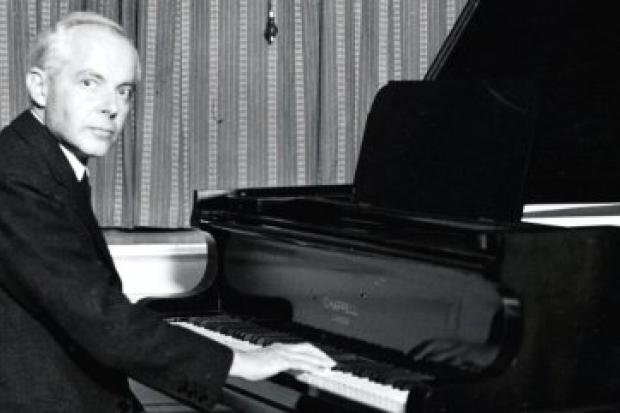A short piece for piano that is built within a ternary form. It consists of three chapters that function almost as movements despite the short length of the composition.
Each part is marked with a tempo mark and an expression (Andante, Risoluto, and back to andante) which may suggest that the last chapter functions as a recapitulation as an A-B-A(variation).
The music starts with an invertible 7 notes theme, which means that the theme can be played in two directions and still sound the same, which makes it mirrored around its axis, g#. Look measure 1.
This theme is imitated in the next measure, however, it’s mirrored in direction. Nevertheless, this imitation is derived from the first appearance, not just in shape, but also in completing the pitch pattern; as the theme contains these intervals: minor seconds and perfect fourths, that makes the continuation up in the soprano precisely according to the pattern. Look measures 1 and 2.

In measure 3 and 4, the same system continues in terms of pitch choice, the only change is the rhythmic divisions as Bartok explores different divisions within the 6\8, however, he maintains the fugal sense and the independence of lines.
Next sentence _which is the next four measure_ follows the same system of theme structure, mirroring, and fugal build. However, from different starting points in order to generate new pitches. Plus the extension of two measures in development that is followed by an extra measure that resembles quasi a cadence that marks the end of the first chapter.


The second chapter, marked with a different character (Risoluto), different time signature(4\4), and different dynamics (forte). This change in dynamics from piano to forte, time signature from 6\8 to 4\4 and melodic lines from fugal to parallel octaves help achieve this new determined and more serious character (Risoluto).
We also notice that this chapter follows a ternary (A-B-Av) form on its own. As (A&B) have the same nature and character with an obvious difference in the register.
A closer look: (A) consists of two phrases that look almost identical except for minor differences that have crucial functions; the first is the ending of each phrase, as we notice the first phrase ends with a leap up suggesting a sort of question or an unsolved issue which resembles a dominant function; however, the second phrase ends with a leap down suggesting a sort of answer or resolution which functions as a tonic.*

* “This symbolic dominant tonic relationship that marks the phrases as well as the fugal content we saw in chapter one, reveal the classical mentality of Bartok and his deep and organic connection to his ancestors.”
(B) consists of the same material of (A), however, with a change in the starting point _in time_ of each line (hand), and a different starting point in terms of pitch. These minor shifts change the whole character again to fugal as independent lines are generated. This session is a reminder of the first chapter but in a different time signature.

(Av) is the closing section of this internal ternary form. (A) comes again with a more serious and determined character as obvious with the fortissimo, the low register and the extra repetition of the tenuto note.

(Av) is extended and ends with a long d that is to be sustained as an organ point for the next chapter.
Third chapter, which is the final of the big ternary form of this piece. Connected to the previous chapter by the d organ point. Time signature changes back to 6\8 and the chapter is marked again with Andante, and as expected, the theme appears again, but not in its original form, as we notice that it has lost its mirrored quality and gained more unique shape and independence. And so the fugal texture continues over the sustained d in the bass

and fades out to finally reach the closing chords that are built from the notes that mark the register of the original theme and its imitation, meaning the highest and lowest notes.

Analyzed by: Samer Aleid



